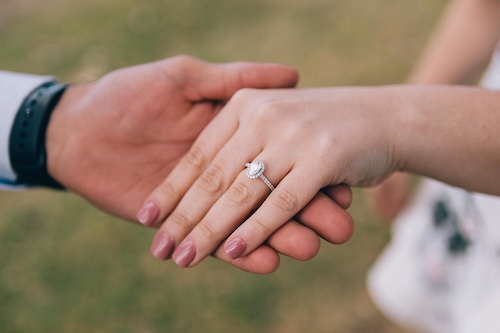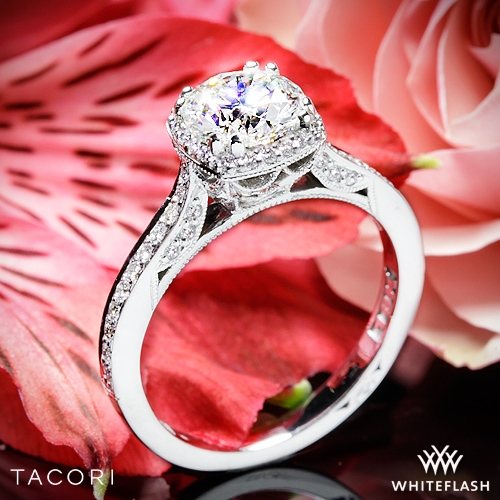In the journey towards finding the perfect engagement ring, lab diamond engagement rings stand out as a modern and ethical choice. These rings combine the timeless beauty of traditional diamonds with a commitment to environmental and ethical responsibility. Lab-grown diamonds, with their exceptional brilliance and craftsmanship, offer an affordable and sustainable alternative without compromising luxury.
What's In This Guide
ToggleThis guide delves into the essentials of lab diamond engagement rings, from the science behind their creation to selecting the ideal setting that suits your style. Whether you are well-versed in the world of fine jewelry or are exploring it for the first time, this guide will equip you with the knowledge to find a ring that not only symbolizes your love but also reflects your values.

Understanding Lab Diamonds
What are Lab Diamonds?
Lab diamonds are real diamonds created in a controlled laboratory setting. They are grown using advanced technological processes that replicate the natural diamond formation beneath the Earth’s crust. The most common methods are High Pressure High Temperature (HPHT) and Chemical Vapor Deposition (CVD), both of which produce diamonds that possess the same physical, chemical, and optical properties as mined diamonds.
Lab vs. Natural Diamonds
While they share identical properties, lab diamonds differ from natural diamonds in their origin. Natural diamonds are formed over billions of years under extreme pressure and heat deep within the Earth. In contrast, lab diamonds are created in a matter of weeks or months. This difference in origin makes lab diamonds more sustainable and ethical, as they do not involve the extensive mining processes associated with natural diamonds.
Ethical and Environmental Advantages
Choosing a lab diamond means supporting a more environmentally friendly and socially responsible option. Lab diamonds reduce the impact of mining on ecosystems, minimize carbon footprints, and ensure no conflict or unethical practices are involved in their production.
The Four Cs of Lab Diamonds
Cut
The cut of a lab diamond determines its brilliance and fire. It’s the art of shaping the diamond to allow the maximum amount of light to enter and reflect. A well-cut lab diamond will appear more luminous and visually appealing.
Color
Lab diamonds come in a range of colors, graded from colorless to light yellow or brown. Colorless diamonds are the most sought-after and rare, both in natural and lab-created forms. The choice of color depends on personal preference and budget.
Clarity
Clarity refers to the absence of inclusions and blemishes in a diamond. Lab diamonds, like natural ones, can have these imperfections. However, they often possess higher clarity as the controlled conditions of a lab minimize the occurrence of inclusions.
Carat
Carat is the measure of a diamond’s weight. With lab diamonds, you can often find a larger carat size for the same budget compared to natural diamonds. This aspect makes lab diamonds an attractive option for those seeking substantial and impressive engagement rings without the steep price.
Understanding these four Cs is crucial in selecting a lab diamond that not only meets your aesthetic preferences but also ensures that you’re making a well-informed and value-driven choice for your engagement ring.
The “Fifth C,” certification, is essential in selecting a high-quality lab diamond. It ensures ethical standards and authenticity. Delve into GIA Certification and IGI Certification to make a well-informed choice for your perfect ring.
The Best Lab Diamond Engagement Ring Settings
Option 1, the Tacori Dantela Collection features settings that beautifully blend contemporary style with traditional elegance, offering a unique juxtaposition that is both classic and unconventional. I am thrilled to showcase a design that embodies strength and sophistication, perfect for the modern woman.
Combine this setting with a diamond from the Whiteflash Precision Lab Grown Diamond Range.
Option 2, is the 14K White Gold Petite Pavé Cathedral Engagement Ring from James Allen. Express your love uniquely with this elegantly designed cathedral-style engagement ring, featuring a sleek prong setting. The ring is beautifully accentuated with pavé detailing, embodying classic sophistication.
Combine this ring with one of their lab created diamonds.
The third option is this simple Petite Elodie Solitaire Engagement Ring. This refined solitaire ring showcases a delicately crafted open basket, holding the central gemstone securely with graceful claw prongs. Its slender band enhances the design’s sleek and timeless elegance.
Combine with a sustainable lab diamond here.
Caring for Your Lab Diamond Ring
Daily Care and Maintenance
Your lab diamond engagement ring is not just a symbol of love, but also an investment that requires proper care. Regular cleaning can keep your diamond sparkling and prevent buildup from daily activities. A simple, gentle cleaning at home can be done using a solution of mild dish soap and warm water. Use a soft brush to gently scrub the diamond and setting, then rinse and dry with a lint-free cloth.
Professional Cleanings and Check-ups
Besides home care, it’s advisable to take your ring to a professional jeweler for a thorough cleaning and inspection at least once a year. They can check for loose stones, weakened prongs, and other potential issues that might not be visible to the untrained eye.
Safekeeping
When not wearing your ring, store it in a fabric-lined jewelry box or a pouch where it won’t get scratched or damaged. It’s also wise to remove your ring during activities that could expose it to harsh chemicals, extreme temperatures, or physical impact, like cleaning, swimming, or exercising.
Pricing and Value
Cost-Effectiveness of Lab Diamonds
Lab diamonds generally offer better value for money compared to natural diamonds. They are priced lower, mainly because the process of creating them is more controlled and less resource-intensive. This price difference allows you to invest in a larger or higher quality diamond for the same budget.
Long-Term Value
While lab diamonds are real diamonds with the same properties as natural ones, there is a perception difference in the market regarding their long-term value. Generally, natural diamonds have held their value more consistently over time. However, as lab diamonds become more accepted and popular, their resale value and market perception are expected to evolve.
Investment Perspective
When purchasing a lab diamond engagement ring, it’s essential to focus on the emotional and symbolic value of the ring, rather than purely its investment potential. Lab diamonds offer the opportunity to make a more impactful statement with your ring, both in terms of size and quality, without the environmental and ethical concerns associated with natural diamonds.
In conclusion, lab diamonds provide a cost-effective, ethical, and sustainable option for engagement rings, combining the timeless beauty and durability of diamonds with modern values and technology.
Where to Buy Lab Diamond Engagement Rings
 When it comes to purchasing a lab diamond engagement ring, selecting a reputable retailer is as crucial as choosing the right diamond. Here are some trusted vendors, each offering a unique selection of lab diamonds and settings to suit your preferences:
When it comes to purchasing a lab diamond engagement ring, selecting a reputable retailer is as crucial as choosing the right diamond. Here are some trusted vendors, each offering a unique selection of lab diamonds and settings to suit your preferences:
- Whiteflash: Known for their exceptional quality and service, Whiteflash offers a stunning collection of lab diamonds. Explore them here.
- Brilliant Earth: Brilliant Earth is renowned for its commitment to ethical sourcing and sustainability. Check out the lab diamond options at Brilliant Earth.
- Blue Nile: As one of the largest online diamond retailers, Blue Nile provides an extensive selection of lab diamonds. Discover their offerings here.
- James Allen: James Allen stands out for their high-quality imagery and customizable options. View their lab diamond collection here.
For a more comprehensive list and detailed reviews of these vendors, visit our article on Where to Buy Lab Diamonds.
Lab diamonds are more than just a trend; they are a testament to how love, ethics, and beauty can coexist in perfect harmony. As you embark on this exciting journey, let your lab diamond engagement ring be a reflection of your values and a symbol of a bright, sustainable future together.



